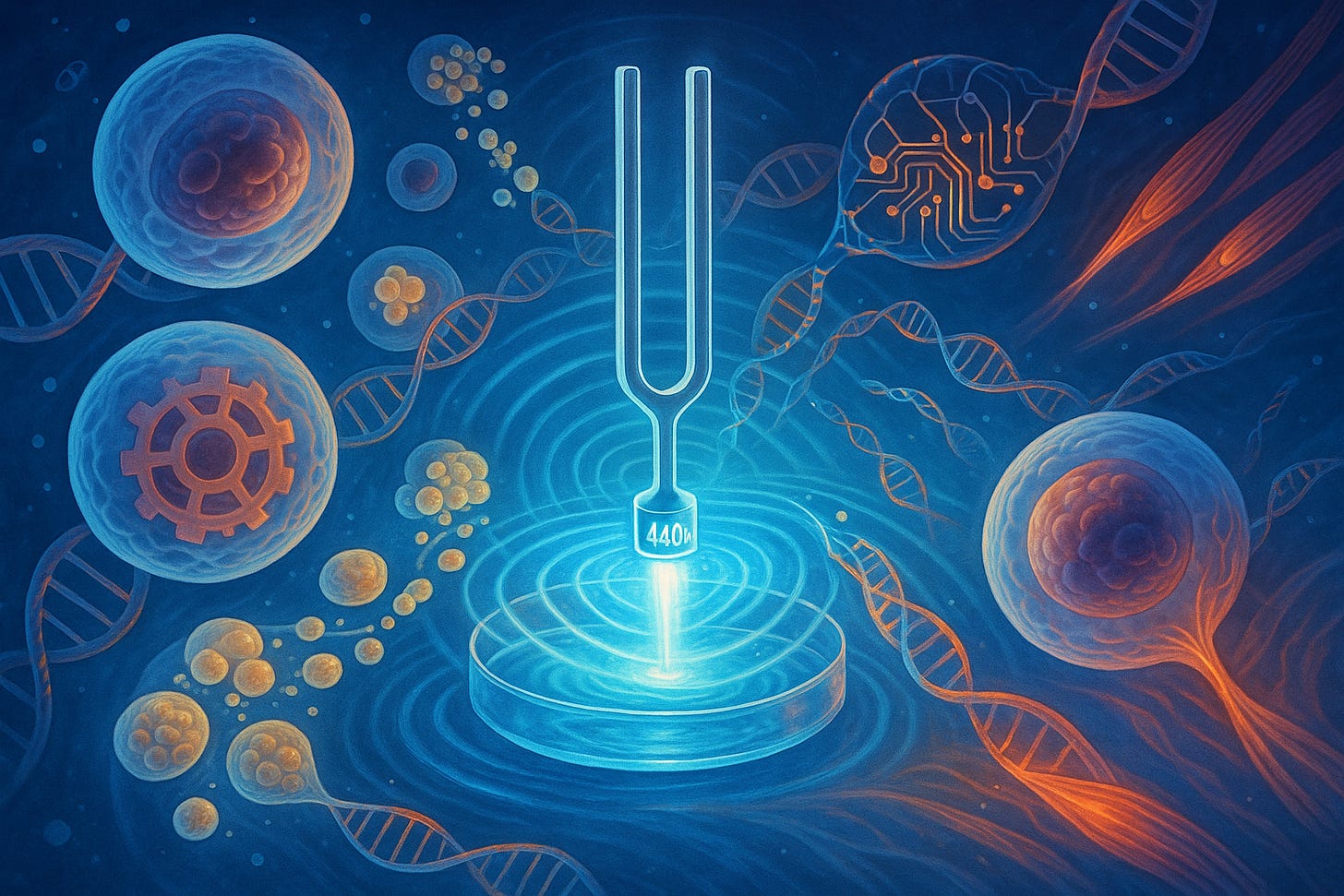Sound Waves Trick Cells Into Fighting Fat
Gene-activating frequencies suppress fat formation and boost cellular health signals.
What if the ambient sounds around you—from your morning alarm to traffic noise—could secretly influence whether your cells burn fat or store it? A groundbreaking study reveals that audible sound waves directly activate genes in living cells, triggering responses that suppress fat cell formation while enhancing tissue repair mechanisms. This discovery opens immediate pathways for using targeted audio frequencies to optimize metabolism and potentially extend healthspan.
What's the Big Idea
Scientists asked whether cells can "hear" everyday sound frequencies and respond at the genetic level—and the answer is a resounding yes. Using a custom acoustic system, researchers exposed mouse muscle cells to three sound patterns: 440 Hz tones (like the musical note A), 14 kHz high-frequency waves, and white noise, all at 100 Pa intensity—roughly equivalent to normal exercise pressure on tissues. Within two hours, 42 genes changed their activity, expanding to 145 genes after 24 hours.
The star player: a gene called Ptgs2 (Cox-2), which ramps up prostaglandin E2 production through a cellular antenna system called focal adhesion kinase, ultimately making cells expand their grip and blocking fat cell development by 13-15 percent.
Why Should You Care
This research suggests your cellular machinery is constantly listening to acoustic cues, potentially reshaping metabolism, inflammation, and tissue repair in real time. The fat-suppressing effects mirror those of exercise-induced mechanical stress, hinting that strategic sound exposure could complement physical activity for weight management.
Long-term implications span from combating age-related muscle loss (sarcopenia) to reducing chronic inflammation through prostaglandin pathways—both critical for extending healthy lifespan. The findings also point toward non-invasive therapies for metabolic disorders, potentially offering personalized acoustic protocols that enhance cognition and muscle function without drugs.
What's Next on the Horizon
Expect wearable devices or smartphone apps designed to deliver precise acoustic frequencies for metabolic optimization—imagine "sound workouts" targeting specific cellular pathways during your commute. Researchers are exploring how these effects translate to humans, whether combining multiple frequencies creates synergistic benefits, and how sound therapy might enhance recovery from injury or surgery.
Open questions include optimal exposure timing, long-term safety thresholds, and whether personalized acoustic profiles based on genetic markers could maximize benefits while minimizing risks.
Safety, Ethics, and Caveats
While the 100 Pa intensities used remain well below hearing damage levels, prolonged or repeated acoustic exposure effects on humans haven't been thoroughly tested—especially regarding unintended gene expression changes or tissue stress. The study focused primarily on muscle and fat precursor cells, showing weaker responses in other cell types, so benefits may not apply universally across tissues or individuals.
Ethical concerns include creating acoustic enhancement technologies accessible only to those who can afford them, potentially widening health disparities, and the need for regulatory oversight of consumer audio devices making health claims.
What This Could Mean for You
Start experimenting cautiously with controlled acoustic environments using free tone generator apps to produce 440 Hz sine waves during 2-hour relaxation or light exercise sessions. Aim for moderate volume levels (around normal conversation, roughly 60-70 decibels) three times weekly, monitoring your energy levels and body composition changes over 2-3 months.
Combine with resistance training on firm surfaces to potentially amplify the matrix-stiffening effects that seem to drive cellular responses. Avoid exceeding 24 hours of exposure per week, especially if you have hearing sensitivities, and consult a healthcare provider before scaling up. Track sleep quality and stress levels, as prostaglandin pathways influence both, and discontinue if you notice any adverse effects.
Explore the Full Study
"Acoustic modulation of mechanosensitive genes and adipocyte differentiation" by Masahiro Kumeta, Makoto Otani, Masahiro Toyoda, and Shige H. Yoshimura, published in Communications Biology (2025). https://doi.org/10.1038/s42003-025-07969-1


